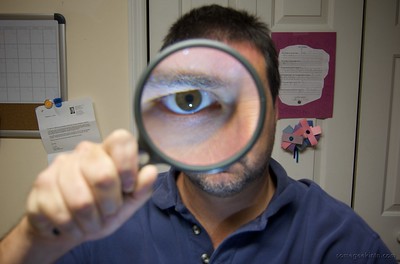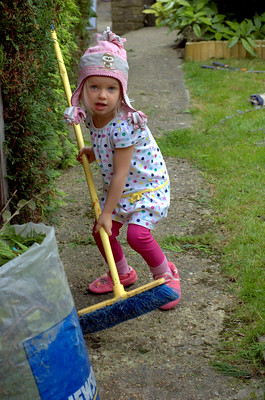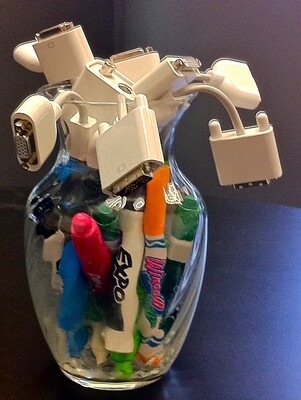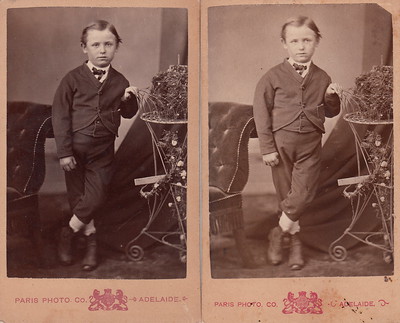Posts Tagged ‘Learning’
The Power of Leaving a Problem Unsolved
 Nothing changes unless there’s a problem.
Nothing changes unless there’s a problem.
In fact, without a problem, there can be no solution.
One of the devious ways to solve your problem is to create conditions for others to think it’s their problem.
Shame on you if you try to get me to solve your problem.
And shame on me if I try to solve your problem.
The best way for the problem to find its rightful owner is to leave the problem unsolved.
But leaving the problem unsolved also increases the pressure on all the innocent non-owners that work near the problem.
Leaving the problem unsolved is like a game of chicken, where the person who flinches first loses.
No one can give you their problem without your consent, but that doesn’t mean they won’t try.
So, when someone tries to give you their problem, put your hands in your pockets.
Leaving the problem unsolved isn’t a sign of non-caring, it’s a sign of higher-level caring.
Leaving the problem unsolved is the only way to pressure the company into the higher-level (and unpleasant) organizational learning of who is not solving their own problems.
“Prepare for Squirting” by Wootang01 is licensed under CC BY-ND 2.0.
What does work look like?
 What does work look like when you prioritize your happiness?
What does work look like when you prioritize your happiness?
When it’s announced that open positions will not be backfilled to meet the practical realities of a recession, you reduce the scope of your projects and push out their completion dates to match the reduction in resources. And the impact on your career? I don’t know, but the people that work for you and everyone else that knows how the work is done will move mountains for you.
Under the banner of standard work, you are given the same task as the one you just completed. Sure, you can do it efficiently and effectively, but if you do that same work one more time, your brain will fall off. So, instead of doing it yourself, you give the work to a lesser-experienced person who is worthy of investment and help them get the work done. They get to learn new skills and the work is done well because you keep them on the straight and narrow. And you get to be a teacher and create a future leader that the company will need in a couple of years. And the downside? The work takes a little longer, but so what.
What does work look like when you prioritize your health?
When an extra-early meeting is scheduled because everyone’s regular day is already fully booked with meetings, you decline the meeting so you can get the recommended amount of sleep recommended by the health professionals. And the negative consequences to your career progression? Well, that’s a choice for your company.
When you get home from work, you disconnect your phone from the company network so you won’t be distracted by work-related interruptions. Because you separated yourself from work, after dinner is cleaned up you can make a healthy lunch for tomorrow. If there’s some downside risk to your career, find another company to work for.
What does work look like when you prioritize your family?
When an extra-late meeting is scheduled because everyone’s regular day is already fully booked with meetings, you decline the meeting so you can cook dinner and eat with your family. The conversation with the kids is mundane and meaningful and ten years from now they’ll be better for it. And the negative consequences? None, because tomorrow morning you can read the minutes of the meeting.
When you’re on your yearly holiday with your family and your boss calls your cell phone to ask you to come back to work early to deal with an emergency, you don’t answer the call and let it go to voicemail. Then, when you get back to the office after vacation, you listen to the voicemail and check in with your boss. And because you didn’t pick up the call, someone else had greatness thrust upon them and developed into someone who can solve emergencies. Now there are two of you. And the downside? Well, I think that depends on your boss.
“Looking For Clues (188 / 365)” by somegeekintn is licensed under CC BY 2.0.
Students, Teachers, and Learning
 If the student has no interest, they are not yet a student and it’s not yet time for learning.
If the student has no interest, they are not yet a student and it’s not yet time for learning.
Learning comes hard, especially when it’s not wanted.
The teacher that tries to teach a student that’s not yet a student is not yet a teacher.
There can be no teacher without a student.
If there’s no doing, there’s no learning. And it’s the same if there’s no theory.
Apprenticeship creates deep learning, but it takes two years.
Learning is inefficient, but it’s far more efficient than not learning.
When you know the student is ready, turn your back so they can see it for themselves.
Objective evidence of deep learning: When students can navigate situations that are outside the curriculum.
“May 14, 2006: Happy Mother’s Day” by Matt McGee is licensed under CC BY-ND 2.0.
Helping helps.
 If you think asking for help is a sign of weakness, you won’t get the help you deserve.
If you think asking for help is a sign of weakness, you won’t get the help you deserve.
If the people around you think asking for help is a sign of weakness, find new people.
As a leader, asking others for help makes it easier for others to ask for help.
When someone asks you for help, help them.
If you’re down in the dumps, help someone.
Helping others is like helping yourself twice.
Helping is caring in action.
If you help someone because you want something in return, people recognize that for what it is.
Done right, helping makes both parties stand two inches taller.
Sometimes the right help gives people the time and space to work things out for themselves.
Sometimes the right help asks people to do work outside their comfort zone.
Sometimes the right help is a difficult conversation.
Sometimes the right help is a smile, a phone call, or a text.
And sometimes the right help isn’t recognized as help until six months after the fact.
Here’s a rule to live by – When in doubt, offer help.
“Helping Daddy” by audi_insperation is licensed under CC BY 2.0.
Problems, Learning, Business Models, and People
 If you know the right answer, you’re working on an old problem or you’re misapplying your experience.
If you know the right answer, you’re working on an old problem or you’re misapplying your experience.
If you are 100% sure how things will turn out, let someone else do it.
If there’s no uncertainty, there can be no learning.
If there’s no learning, your upstart competitors are gaining on you.
If you don’t know what to do, you’ve started the learning cycle.
If you add energy to your business model and it delivers less output, it’s time for a new business model.
If you wait until you’re sure you need a new business model, you waited too long.
Successful business models outlast their usefulness because they’ve been so profitable.
When there’s a project with a 95% chance to increase sales by 3%, there’s no place for a project with a 50% chance to increase sales by 100%.
When progress has slowed, maybe the informal networks have decided slower is faster.
If there’s something in the way, but you cannot figure out what it is, it might be you.
“A bouquet of wilting adapters” by rexhammock is licensed under CC BY-SA 2.0.
How To Solve Transparent Problems
 One of the best problems to solve for your customers is the problem they don’t know they have. If you can pull it off, you will create an entirely new value proposition for them and enable them to do things they cannot do today. But the problem is they can’t ask you to solve it because they don’t know they have it.
One of the best problems to solve for your customers is the problem they don’t know they have. If you can pull it off, you will create an entirely new value proposition for them and enable them to do things they cannot do today. But the problem is they can’t ask you to solve it because they don’t know they have it.
To identify problems customs can’t see, you’ve got to watch them go about their business. You’ve got to watch all aspects of their work and understand what they do and why they do it that way. And it’s their why that helps you find the transparent problems. When they tell you their why, they tell you the things they think cannot change and the things they consider fundamental constraints. Their whys tell you what they think is unchangeable. And from their perspective, they’re right. These things are unchangeable because they don’t know what’s possible with new technologies.
Once you know their unchangeable constraints, choose one to work on and turn it into a tight problem statement. Then use your best tools and methods to solve it. Once solved, you’ve got to make a functional prototype and show them in person. Without going back to them with a demonstration of a functional prototype, they won’t believe you. Remember, you did something they didn’t think was possible and changed the unchangeable.
When demonstrating the prototype to the customer, just show it in action. Don’t describe it, just show them and let them ask questions. Listen to their questions so you can see the prototype through their eyes. And to avoid leading the witness, limit yourself to questions that help you understand why they see the prototype as they do. The way they see the prototype will be different than your expectations, and that difference is called learning. And if you find yourself disagreeing with them, you’re doing it wrong.
This first prototype won’t hit the mark exactly, but it will impress the customer and it will build trust with them. And because they watched the prototype in action, they will be able to tell you how to improve it. Or better yet, with their newfound understanding of what’s possible, they might be able to see a more meaningful transparent problem that, once solved, could revolutionize their industry.
Customers know their work and you know what’s possible. And prototypes are a great way to create the future together.
“Transparent” by Rene Mensen is licensed under CC BY 2.0.
Triangulation of Leadership
Put together things that contradict yet make a wonderfully mismatched pair.
Say things that contradict common misunderstandings.
See the dark and dirty underside of things.
Be more patient with people.
Stomp on success.
Dissent.
Tell the truth even when it’s bad for your career.
See what wasn’t but should have been.
Violate first principles.
Protect people.
Trust.
See things as they aren’t.
See what’s missing.
See yourself.
See.
“man in park (triangulation)” by Josh (broma) is licensed under CC BY 2.0.
Same-But-Different, A Superpower That Can Save The Day
 If there’s one superpower to develop, it’s to learn how to assess a project and get a good feel for when it will launch.
If there’s one superpower to develop, it’s to learn how to assess a project and get a good feel for when it will launch.
When you want to know how long a project will take, ask this simple question: ‘What must the project team learn before the project can launch?” By starting with this single question, you will start the discussion that will lead you to an understanding of what hasn’t been done before and where the uncertainty is hiding. And if there’s one thing that can accelerate a project, it’s defining where the uncertainty is hiding. And knowing this doubly powerful, like a pure two-for-one, because if you know where uncertainty is, by definition, you know where it isn’t. Where the uncertainty isn’t, you can do what you did last time, and because you’ve done it before, you know how long it will take. No new tools, no new methods, no new analyses, no new machines, no new skillsets, no new anything. And for the remaining elements of the project, well, that’s where the uncertainty is hiding and that’s where you will focus on the learning needed to secure the launch.
But it can be difficult to understand the specific learning that must be done for a project to launch. One trick I like to use is the Same-But-Different method. It goes like this. Identify a project that launched (Project A) that’s most similar to the one that will launch next (Project B) and perform a subtraction of sorts. Declare that Project B (the one you want to launch) is the same as Project A (the one you already launched) but different in specific ways and then define those differences as clearly and tightly as possible. And where it’s different, that’s where the learning energy must be concentrated.
Same-But-Different sounds simplistic and trivial, but it isn’t. More than anything, it’s powerful. For the elements that are the same, you do what you did last time, which is freeing. And for the small subset if things that are different, you dig in!
Same-But-Different drives deep clarity and extreme focus, which result in blistering progress and blinding effectiveness.
And for some reason unknown to me, asking a team to define the novel elements of a project is at least fifty times more difficult than asking them how Project B is different than Project A. So, it feels good to the team when they can use Same-But-Different to quickly easily define what’s different and then point directly to the uncertainty. And once the team knows where the uncertainty is hiding, it’s no longer hiding.
And if there’s one thing a project team likes, it’s knowing where the uncertainty is hiding.
“The same, but different by the Paris Photographic Co. (c.1880)” by pellethepoet is marked with CC BY 2.0.
Things I Sometimes Forget
 Clean-sheet designs are fun, right up until they don’t launch.
Clean-sheet designs are fun, right up until they don’t launch.
When you feel the urge to do a clean-sheet design, go home early.
When you don’t know how to make it better, make it worse and do the opposite.
Without trying, there is no way to know if it will work.
Trying sometimes feels like dying.
But without trying, nothing changes.
Agreement is important, but only after the critical decision has been made.
When there’s 100% agreement, you waited too long to make the decision.
When it’s unclear who the customer is, ask “Whose problem will be solved?”
When the value proposition is unclear, ask ‘What problem will be solved?”
When your technology becomes mature, no one wants to believe it.
When everyone believes the technology is mature, you should have started working on the new technology four years ago.
If your projects are slow, blame your decision-making processes.
Two of the most important decisions: which projects to start and which to stop.
All the action happens at the interfaces, but that’s also where two spans of control come together and chafe.
If you want to understand your silos and why they don’t play nicely together, look at the organizational chart.
When a company starts up, the product sets the organizational structure.
Then, once a company is mature, the organizational structure constrains the product.
At the early stages of a project, there’s a lot of uncertainty.
And once the project is complete, there’s a lot of uncertainty.
“Toys Never Forget” by Alyssa L. Miller is marked with CC BY 2.0.
When You Have No Slack Time…
 When you have no slack time, you can’t start new projects.
When you have no slack time, you can’t start new projects.
When you have no slack time, you can’t run toward the projects that need your help.
When you have no slack time, you have no time to think.
When you have no slack time, you have no time to learn.
When you have no slack time, there’s no time for concern for others.
When you have no slack time, there’s no time for your best judgment.
When there is no slack time, what used to be personal becomes transactional.
When there is no slack time, any hiccup creates project slip.
When you have no slack time, the critical path will find you.
When no one has slack time, one project’s slip ripples delay into all the others.
When you have no slack time, excitement withers.
When you have no slack time, imagination dies.
When you have no slack time, engagement suffers.
When you have no slack time, burnout will find you.
When you have no slack time, work sucks.
When you have no slack time, people leave.
I have one question for you. How much slack time do you have?
“Hurry up Leonie, we are late…” by The Preiser Project is licensed under CC BY 2.0
Testing is an important part of designing.
 When you design something, you create a solution to a collection of problems. But it goes far beyond creating the solution. You also must create objective evidence that demonstrates that the solution does, in fact, solve the problems. And the reason to generate this evidence is to help the organization believe that the solution solves the problem, which is an additional requirement that comes with designing something. Without this belief, the organization won’t go out to the customer base and convince them that the solution will solve their problems. If the sales team doesn’t believe, the customers won’t believe.
When you design something, you create a solution to a collection of problems. But it goes far beyond creating the solution. You also must create objective evidence that demonstrates that the solution does, in fact, solve the problems. And the reason to generate this evidence is to help the organization believe that the solution solves the problem, which is an additional requirement that comes with designing something. Without this belief, the organization won’t go out to the customer base and convince them that the solution will solve their problems. If the sales team doesn’t believe, the customers won’t believe.
In school, we are taught to create the solution, and that’s it. Here are the drawings, here are the materials to make it, here is the process documentation to build it, and my work here is done. But that’s not enough.
Before designing the solution, you’ve got to design the tests that create objective evidence that the solution actually works, that it provides the right goodness and it solves the right problems. This is an easy thing to say, but for a number of reasons, it’s difficult to do. To start, before you can design the right tests, you’ve got to decide on the right problems and the right goodness. And if there’s disagreement and the wrong tests are defined, the design community will work in the wrong areas to generate the wrong value. Yes, there will be objective evidence, and, yes, the evidence will create a belief within the organization that problems are solved and goodness is achieved. But when the sales team takes it to the customer, the value proposition won’t resonate and it won’t sell.
Some questions to ask about testing. When you create improvements to an existing product, what is the family of tests you use to characterize the incremental goodness? And a tougher question: When you develop a new offering that provides new lines of goodness and solves new problems, how do you define the right tests? And a tougher question: When there’s disagreement about which tests are the most important, how do you converge on the right tests?
Image credit — rjacklin1975

 Mike Shipulski
Mike Shipulski